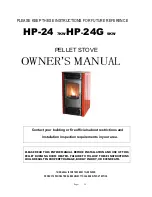
Vienybė EKO ex
Vienybė EKO ex
Vienybe EKO ex (17.01) EN
Vienybe EKO ex (17.01) EN
9
8
4.2. Requirements for flue and chimney
Metal pipes used for connection of the fireplace to a chimney must be made of at least 1,5 mm
thickness metal sheet.
A chimney, a flue pipe and air-ducts must comply with construction regulations and rules. A
diameter of a chimney hole must be at least
Ø 130 mm.
The fireplace must be connected to a separate chimney; no other devices can be connected to it.
Minimum draught of the chimney at nominal power is 12 Pa. In case the chimney draught is too
strong, a smoke valve or draught regulator may be installed. It may be installed inside flue or
chimney. The minimum recommended height of the chimney is 5 m above the fireplace. The top of
the chimney must be above the highest point of a roof.
An opening for chimney cleaning must be provided. It is recommended to clean the chimney
and flue before a heating season and every 3 months afterwards. The flue and chimney must be
inspected for any blockages if the fireplace was not used for a long period of time.
It is recommended to install stainless steel liner inside the chimney to protect it from harmful
effects of moisture condensation and smoke exposure.
A flue, connecting the fireplace and the chimney, must be as short as possible and must be
directed up towards the chimney. The maximum recommended horizontal length of the flue is 1 m.
In order to connect a flue to a brick chimney:
-
mark a place where the flue will be connected;
-
using suitable tools make a hole that is slightly bigger than the diameter of the flue;
-
insert the flue. Seal the spaces with fireproof material, e.g., rock wool or glass cord.
5. Use
ATTENTION!
Maintenance of the fireplace shall be performed only by adults having read this
user's manual. During the use of the fireplace the surface of the fireplace becomes hot; a risk of
burns arises. When opening / closing the door, and adjusting the control valves, it is necessary
to wear protective glove (included in the set). Prior to heating the fireplace make sure there are
no flammable items on it.
5.1. First heating
During the first heating of the fireplace it can emit a specific smell and visible vapors, and it may
seem that smoke is flowing into a room instead of flowing through the chimney. This should stop
after 1 or 2 full and intensive heating cycles. It is necessary to have a good ventilation of the room
during the first heating of the fireplace. Later on the fireplace may be heated normally.
5.2. Heating
Firing up. Fully open an initial air supply valve 5 by shifting it to the left (see Fig. 1.) Fully open a
secondary air supply valve by pulling it towards yourself. Put two average size pieces of firewood
on the bottom of a combustion chamber; leave a gap between those two pieces. Put some
crumpled newspaper or a solid fuel tablet in the gap, then put some shredded and dry firewood
in a crosswise manner and then some average size firewood on top. Light up the paper and
close the door when the paper starts to burn well. A handle of the door may be hot; therefore a
safety glove should be used. Control the intensity of fire with the help of air supply valve.
Adding fuel.
The first load of fuel must burn completely, i.e., only embers must remain in the
fireplace before adding a new load. It is necessary to slightly open the door in order to even out the
air pressure before the door is opened fully. This will prevent smoke from entering a room,
especially when chimney draught is weak. After adding a new load of fuel it is necessary to close
the fireplace door and fully open primary air supply valve for approximately 5 seconds for the fuel
to start burning well. After this the valves should be closed leaving only a small gap as during the
normal heating. In order to prevent fireplace from overheating it is recommended to use 2,5 kg of
firewood for one load at most. It is recommended to put the firewood parallel to the glass.
ATTENTION!
When adding firewood into the fireplace make sure it does not touch the glass.
Heating during adverse weather conditions.
In certain cases, e.g., when ambient
temperature is above 15
°
C, the weather is rainy and damp, or when a wind is gusty etc., the
chimney draught might be worse than usual. In such cases a minimum amount of fuel should be
used in the fireplace, and the initial air supply valve should be fully opened.
5.3. Ash cleaning
After the fuel has burnt, ashes should be removed from the combustion chamber into an ashbin
using a suitable rake. Ashes should be removed only after they have cooled completely. Ashes
should be poured into a fire-resistant container. Ashes must be removed after every heating;
otherwise they can block the air supply.
5.4. Fuel
ATTENTION!
Only the recommended type of fuel shall be used for heating; use of other type of
fuel (e.g. coal) may result in overheating of the fireplace. In such case the warranty would not be
applied.
The fireplace is designed for use with firewood (deciduous trees recommended). Firewood should
be cut and split. Humidity of firewood used for heating should not be higher than 20%. Such
firewood humidity level is achieved after 1 to 2 year storage of the firewood in a ventilated shelter.
Use of damp firewood results in reduced power of a fireplace, increased consumption of fuel;
accumulation of resins, cracking of vermiculite plates and faster corrosion of combustion
chamber. Due to higher accumulation of resins use of coniferous firewood is not recommended.
Summary of Contents for EKO ex
Page 2: ......


























